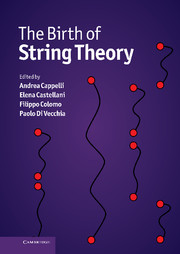Book contents
- Frontmatter
- Contents
- List of contributors
- Photographs of contributors
- Preface
- Abbreviations and acronyms
- Part I Overview
- 1 Introduction and synopsis
- 2 Rise and fall of the hadronic string
- 3 Gravity, unification, and the superstring
- 4 Early string theory as a challenging case study for philosophers
- EARLY STRING THEORY
- Part II The prehistory: the analytic S-matrix
- Part III The Dual Resonance Model
- Part IV The string
- TOWARDS MODERN STRING THEORY
- Part V Beyond the bosonic string
- Part VI The superstring
- Part VII Preparing the string renaissance
- Appendix A Theoretical tools of the Sixties
- Appendix B The Veneziano amplitude
- Appendix C From the string action to the Dual Resonance Model
- Appendix D World-sheet and target-space supersymmetry
- Appendix E The field theory limit
- Index
2 - Rise and fall of the hadronic string
from Part I - Overview
Published online by Cambridge University Press: 05 May 2012
- Frontmatter
- Contents
- List of contributors
- Photographs of contributors
- Preface
- Abbreviations and acronyms
- Part I Overview
- 1 Introduction and synopsis
- 2 Rise and fall of the hadronic string
- 3 Gravity, unification, and the superstring
- 4 Early string theory as a challenging case study for philosophers
- EARLY STRING THEORY
- Part II The prehistory: the analytic S-matrix
- Part III The Dual Resonance Model
- Part IV The string
- TOWARDS MODERN STRING THEORY
- Part V Beyond the bosonic string
- Part VI The superstring
- Part VII Preparing the string renaissance
- Appendix A Theoretical tools of the Sixties
- Appendix B The Veneziano amplitude
- Appendix C From the string action to the Dual Resonance Model
- Appendix D World-sheet and target-space supersymmetry
- Appendix E The field theory limit
- Index
Summary
Abstract
A personal account is given of the six to seven years (1967–1974) during which the hadronic string rose from down-to-earth phenomenology, through some amazing theoretical discoveries, to its apotheosis in terms of mathematical beauty and physical consistency, only to be doomed suddenly by the inexorable verdict of experiments. The a posteriori reasons forwhy the theorists of the time were led to the premature discovery of what has since become a candidate Theory of Everything, are also discussed.
Introduction and outline
In order to situate historically the developments I will be covering in this Chapter, let me start with a picture (see Figure 2.1) illustrating, with the help of Michelin-guide-style grading, the amazing developments that took place in our understanding of elementary particle physics from the mid-Sixties to the mid-Seventies. Having graduated from the University of Florence in 1965, I had the enormous luck to enter the field just at the beginning of that period which, a posteriori, can rightly be called the ‘golden decade’ of elementary particle physics.
The theoretical status of the four fundamental interactions was very uneven in the mid-Sixties: only the electromagnetic interaction could afford an (almost1) entirely satisfactory description (hence a 3-star status) according to quantum electrodynamics (QED), the quantum-relativistic extension of Maxwell's theory. Gravity too had a successful theoretical description, this time according to Einstein's general relativity, its 2-star rating being related to the failure of all attempts to construct a consistent quantum extension.
Information
- Type
- Chapter
- Information
- The Birth of String Theory , pp. 17 - 36Publisher: Cambridge University PressPrint publication year: 2012
Accessibility standard: Unknown
Why this information is here
This section outlines the accessibility features of this content - including support for screen readers, full keyboard navigation and high-contrast display options. This may not be relevant for you.Accessibility Information
- 2
- Cited by
